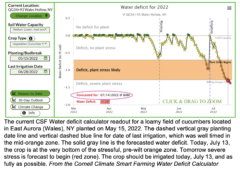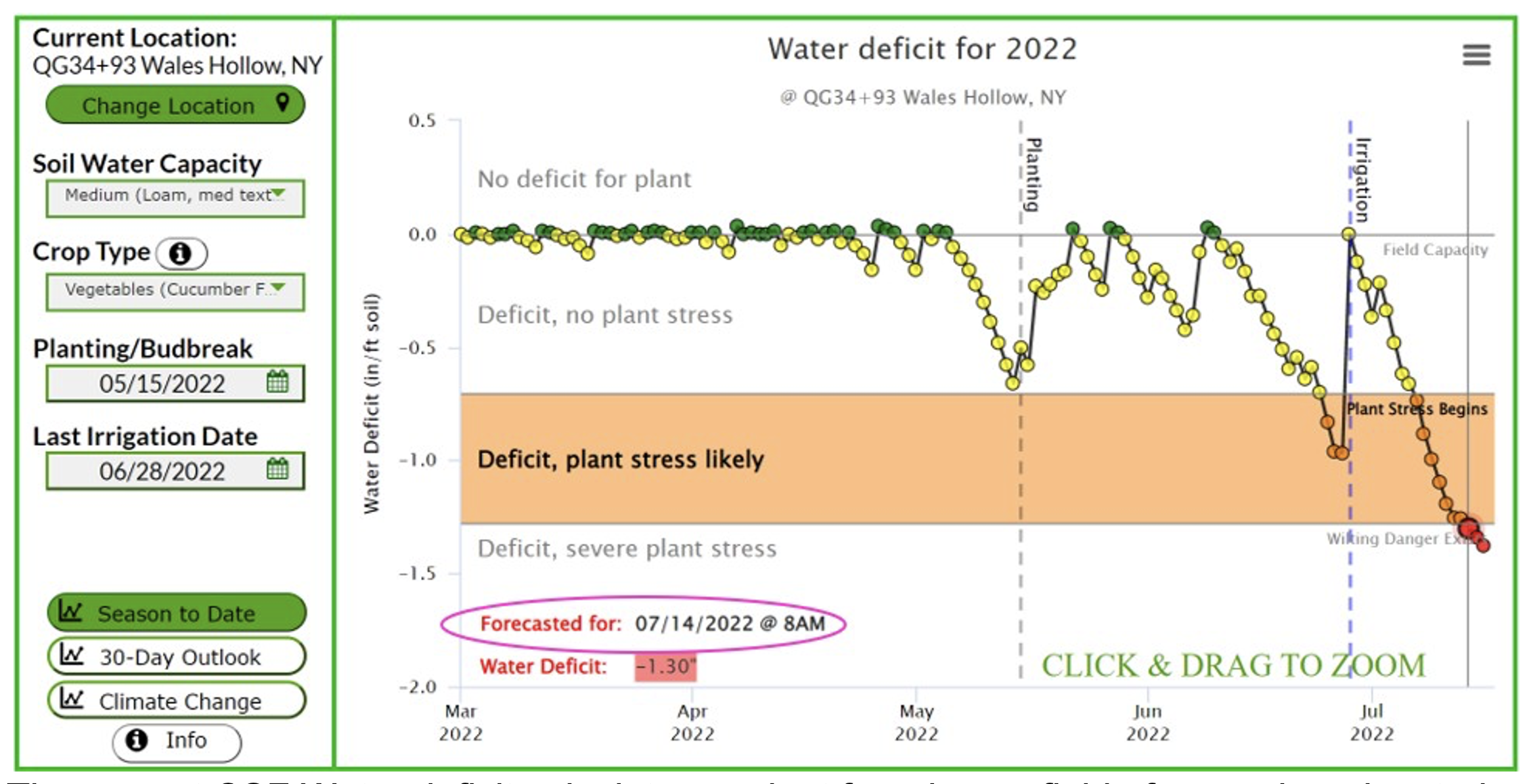by Elizabeth Buck, Cornell Cooperative Extension, Cornell Vegetable Program
As of last Thursday, U.S. Drought Monitor officially designated almost all of the Cornell Vegetable Program area as “abnormally dry”, which is their first stage of drought. It’s not hard to spot the corn rolling as you drive, particularly in the later plantings, and the ground cracks developing. Streams are running low and ponds are getting drawn down. The depletion of those surface water resources is quickly demanding a question be answered: How do I make the most impactful use of the water I do have?
Watering Efficiency
Look for and fix leaks. Trickle tape is highly efficient. For overhead systems, windy conditions drive droplets off course and increase evaporation. Watering at night reduces losses to heat, sun, and wind-driven evaporation, though the practice can increase your disease risk. You’ll increase your watering efficiency if you can wait until night. But when it is that windy and dry, the crop often can’t wait, especially big leafy crops like pumpkins and winter squashes on plastic.
For trickle, do you have a single header watering several kinds of crops? Say you have a couple of cuke rows and some cabbages or kale. The cole crops don’t need as much water as the cukes and tolerate drought much better, so consider shutting off their header valves every other watering or part way through an irrigation.
Know Your Soils
Do you have high or low organic matter? What’s your field’s innate ability to hold water? Higher OM fields will provide more water storage and improve the infiltration of any irrigation or rain.
Where are the high patches in a field, or the sandier, gravelly areas? The heavier ground? Can the irrigation be adjusted to deliver variable amounts of water to these zones? With a reel this will take manual monitoring and adjustment of the reel speed and could be a strategy if you have big soil differences along the length of a pass.
Compaction, ground cracking, and prior root development play a role, too. Compacted ground keeps roots shallow and more dependent on supplemental water. Cracked ground can deposit water below the bulk of the root zone. Plants that were in spring wet spots, that suffered root rot or root feeding, and crops that have always been regularly irrigated to sufficiency tend to have shallower root systems. Crops with shallow feet are much more dependent on regular irrigation and show more stress when you shift to maintaining the soil water in a partial-deficit condition.
Know Your Prioritization
What are your most economically important crops? Which crops are in their most important stage for receiving water? Which crops are unlikely to be economic performers and could be sacrificed? If you’re choosing between a bean field about/in flower, and a bean field with poor stand and past root rot, it is a better economic move to water the plants in the critical flowering stage to ensure that you realize your yield potential.
Know When it is Time to Quit Watering a Crop
Have a zucchini crop filled with powdery and a second planting coming into production? Or a cuke crop blasted with downy? Fresh market beans that you’ve already been through 2 or 3 times? Quit watering them and if they’re diseased mow them off. On the upside, you’ll save time and money by no longer needing to manage the diseases and pests and realize labor savings by forgoing an inefficient (small amount, lots of hunting) harvest.
Yes, it can be a gut-punch to sacrifice a planting or give up on something while there’s still a bit of fruit coming. But think longer-term and think economically, not emotionally. Save your water for areas with better economic performers.
Don’t Get Too Far Behind
There are some soils and crops that are very difficult to catch up on water status. Fields that are cracked, crusted, or that have a heavy dust mulch can become difficult to move water into the root zone. Pay close attention to fields that are sandy, have shrinking clay components that make them prone to cracking, and those with poor soil structure. Crop type matters, too. Some crops can tolerate living in the somewhat stressful water deficit conditions. Other crops have a very hard time recovering to full water status once they become overly dry.
Use Monitoring Tools
I like the Cornell Climate Smart Farming Water Deficit Calculator as a monitoring tool. It’s user-friendy, it only takes 3-5 minutes to set up a field, you can save many fields in the tool, and you can enter your irrigation events. The little info button is very helpful for crop groupings.
The CSF Water Deficit Calculator uses your soil texture, crop category, and high-resolution weather observations and forecasts as the base of the model. Importantly, it takes evapotranspiration into account, meaning it models more water loss from the soil on those hot, windy days. The tool then forecasts the amount of water stress your plant will experience and groups the water depletion into crop-specific categories that I’ll paraphrase as “green – full water”, “yellow – sufficient”, “orange – I’m stressed, but I’ll live”, and “red – water me yesterday” categories.

The goal is to water when you enter the orange zone and never let the crop get into the red zone. The orange zone may be insufficient for some crops at some stages. The orange zone would be too dry for corn during pollination, beans during flowering, or fruiting tomatoes that aren’t used to infrequent or variable water availability.
If you know your most water-sensitive stages and crops, you can use the CSF Water Deficit Calculator to help you decide which field has to get water today and which one has some room to go before it gets into a troublesome zone. Of course, nothing is better than going out and sticking your hand in the soil, but this tool can provide a good starting point.
Every time it rains the tool calculates if the rainfall was enough to bring the soil completely or only partially back to full water status. If you enter an irrigation date, a dashed vertical blue line will appear. Right now, the tool assumes you’re irrigating back to field capacity. This is a flaw that you’ll have to take into consideration. There are plans to add a new feature with the next update that will allow growers to input the amount of their last irrigation to further increase the accuracy of the tool. Case studies have shown that the current version of the CSF Water Deficit Calculator is still a useful irrigation management tool.

